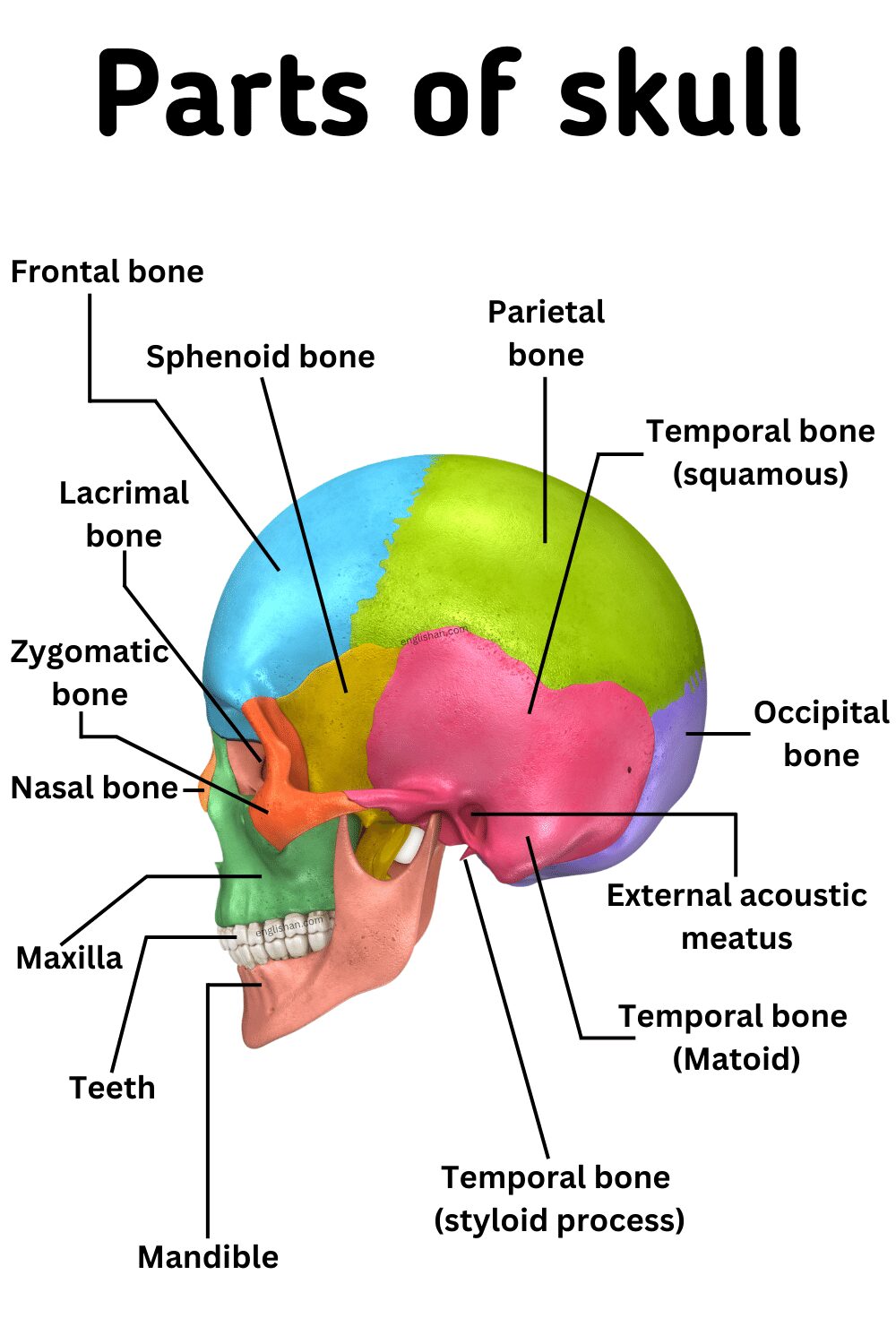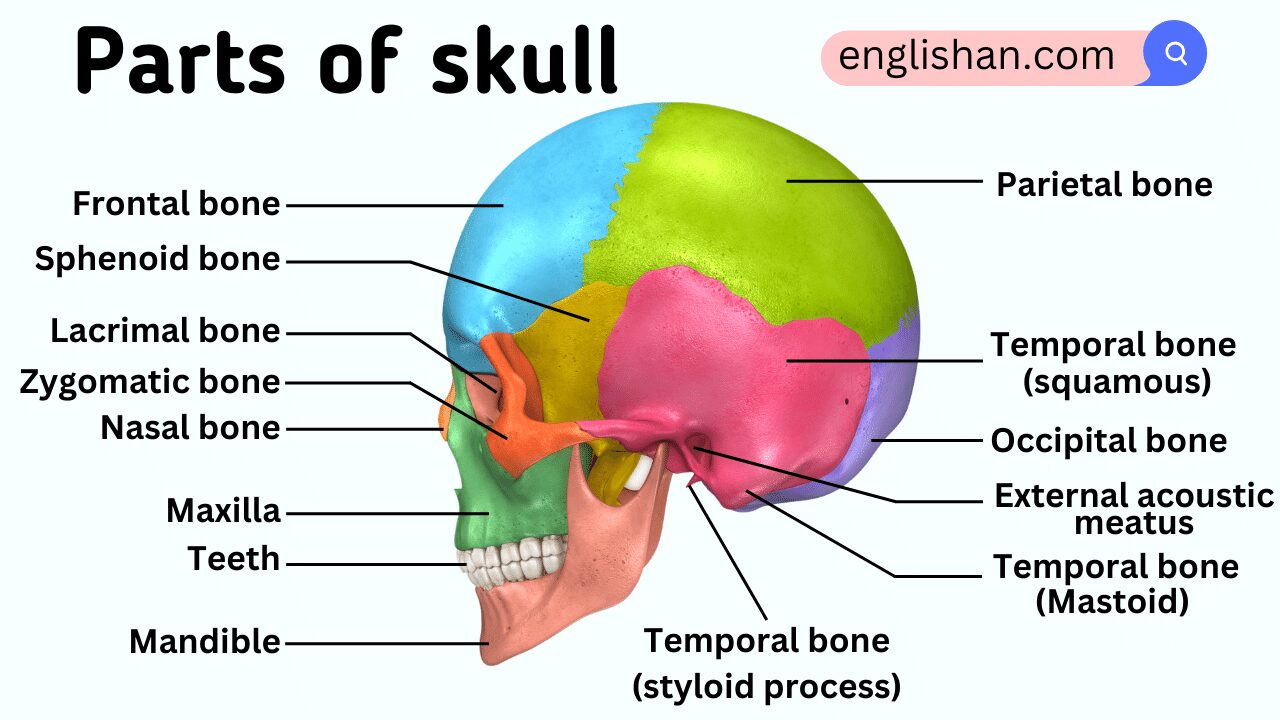Contents
In this blog post, you will learn the names and functions of different parts of the skull in English. The skull is an important structure that protects the brain and supports the face. Each part has a specific role in shaping the head and allowing movement. Understanding these names will help improve your vocabulary, especially in science and medicine.
To learn more vocabulary on different topics, visit our vocabulary category.
What Is the Skull?
The skull is the bony structure that forms the head in vertebrates. It supports the structures of the face and provides a protective cavity for the brain. The skull is divided into two main parts: the cranium and the facial bones.
- Cranium: The cranium is the upper part of the skull that encloses and protects the brain. It consists of several bones that are fused together.
- Facial Bones: The facial bones form the structure of the face, including the jaw, cheeks, and nasal cavity.

The Cranial Bones
The cranium is composed of eight bones that are designed to protect the brain and support the structures of the head.
- Frontal Bone: The frontal bone forms the forehead and the upper part of the eye sockets. It plays a crucial role in protecting the frontal lobe of the brain, which is responsible for decision-making, problem-solving, and controlling behavior.
- Parietal Bones: The two parietal bones are located on the sides and roof of the cranium. These bones protect the brain’s parietal lobes, which process sensory information such as touch, temperature, and pain.
- Temporal Bones: Located near the lower sides of the cranium, the temporal bones house the structures of the ears and protect the brain’s temporal lobes. These lobes are involved in hearing, memory, and speech.
- Occipital Bone: The occipital bone forms the back of the skull and the base of the cranium. It protects the occipital lobe of the brain, which processes visual information.
- Sphenoid Bone: The sphenoid bone is located in the middle of the skull, between the frontal and temporal bones. It has a butterfly shape and contributes to the structure of the eye sockets, protecting the brain’s sphenoid sinus and other key areas.
- Ethmoid Bone: The ethmoid bone is a light, spongy bone located between the eyes. It forms part of the nasal cavity and the orbits (eye sockets) and protects the olfactory (smell) receptors.
The Facial Bones
The facial bones are responsible for the shape and structure of the face. They also provide cavities for the sense organs (eyes, nose, and mouth) and serve as attachment points for facial muscles.
- Mandible: The mandible, or lower jawbone, is the largest and strongest bone of the face. It holds the lower teeth and forms the lower jaw, enabling chewing and speaking.
- Maxilla: The maxilla is the upper jawbone, which holds the upper teeth and forms the roof of the mouth (hard palate), the floor of the nose, and the bottom of the eye sockets.
- Zygomatic Bones: Also known as the cheekbones, the zygomatic bones form the prominence of the cheeks and the outer edges of the eye sockets. They play a role in facial expressions and protecting the eyes.
- Nasal Bones: The nasal bones are two small bones that form the bridge of the nose. They are located between the eyes and above the nasal cavity.
- Lacrimal Bones: The lacrimal bones are the smallest and most fragile bones of the face. They are located in the inner corners of the eye sockets and help form the nasolacrimal canal, which carries tears from the eyes to the nasal cavity.
- Vomer: The vomer is a thin, flat bone located in the nasal cavity. It forms the lower part of the nasal septum, which divides the nasal cavity into two nostrils.
- Palatine Bones: The palatine bones are two bones that form the back part of the hard palate and the floor of the nasal cavity. They contribute to the structure of the oral and nasal cavities.
- Inferior Nasal Conchae: The inferior nasal conchae are thin, curved bones located within the nasal cavity. They help filter and humidify the air that passes through the nose.
Sutures of the Skull
The bones of the skull are connected by immovable joints called sutures. These sutures allow the bones to fuse together, forming a solid and protective structure.
- Coronal Suture: The coronal suture runs across the top of the skull, connecting the frontal bone to the parietal bones.
- Sagittal Suture: The sagittal suture runs down the middle of the skull, connecting the two parietal bones.
- Lambdoid Suture: The lambdoid suture is located at the back of the skull, connecting the parietal bones to the occipital bone.
- Squamous Suture: The squamous sutures are located on the sides of the skull, connecting the parietal bones to the temporal bones.
Functions of the Skull
The skull serves several vital functions, making it one of the most important structures in the human body.
- Protection: The primary function of the skull is to protect the brain, one of the most critical organs in the body. The thick bones of the cranium act as a hard shell, shielding the brain from injury.
- Support: The skull provides a framework for the face, supporting the eyes, nose, mouth, and ears. It also provides attachment points for muscles involved in chewing, speaking, and facial expressions.
- Sensory Function: The skull houses and protects the sensory organs, including the eyes, ears, and nose, allowing us to see, hear, smell, and taste.
- Speech and Eating: The jawbones, including the mandible and maxilla, play a crucial role in speaking and eating. They hold the teeth and enable movements required for chewing and articulation.
Conclusion
Understanding the parts of the skull and their functions is essential for appreciating the complexity of the human body. From protecting the brain to supporting the face and sensory organs, the skull is a marvel of biological engineering. By learning the names and functions of the various skull parts, we gain a deeper understanding of how our bodies are designed to protect and serve us throughout our lives.
You May Also Like






